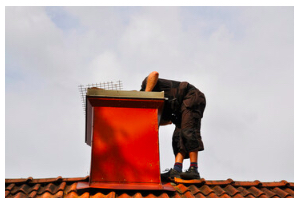 Chimney Inspection should be part of your routine maintenance plan. Detecting small issues in the early stages is important to avoid bigger problems.
Chimney Inspection should be part of your routine maintenance plan. Detecting small issues in the early stages is important to avoid bigger problems.
During this inspection, the chimney sweep will examine all accessible areas of the fireplace and flue. This includes the outside of the chimney, where deteriorated bricks or crumbling mortar are impact hazards, and the firebox inside.
A level 1 inspection includes visually examining the readily accessible portions of the chimney’s exterior, interior, and accessible portions of the fireplace and chimney connection. This type of inspection will determine whether the masonry and the flue are sound and if there are any blockages or obstructions that would prevent a chimney from working properly.
During a level 1 inspection, the chimney sweep will check the condition of your fireplace and chimney and look for areas that may need cleaning or repair. This level of inspection will also ensure that toxic gases like carbon monoxide, which is odorless, colorless, and tasteless, aren’t leaking into your home from the chimney.
This is the most frequently performed type of chimney inspection. It’s recommended for chimneys that are in regular use and haven’t experienced any changes to the appliance, fireplace, or flue. It’s important to get a level 1 chimney inspection annually to keep the flue and chimney clear of creosote and other debris that can easily ignite.
If a level 1 inspection suggests a hidden hazard, a level 2 chimney inspection should be done immediately. During this more detailed and invasive chimney inspection, a video scan of the entire flue is conducted. The technician will also examine the portions of the chimney inside attics, basements, and crawl spaces that are usually hard to reach.
Sometimes a level 2 inspection will uncover a major problem that a homeowner was unaware of. For example, a home buyer might not know when the fireplace was last inspected and could be surprised by a dangerous chimney problem. These issues can include structural damage, deterioration, or even a chimney fire. In such cases, a level 2 inspection is often required before the property can be sold.
A level 2 inspection can also help homeowners save money on their homeowner’s insurance. Many policies require regular chimney inspections before they will compensate homeowners for damage caused by the use of a fireplace or wood-burning stove. Skipping a chimney inspection could lead to costly repairs in the future and may even cause your homeowners’ policy to be canceled.
Chimneys and fireplaces produce a lot of smoke, soot, and creosote, which is highly flammable. Getting a chimney inspected and properly swept helps ensure that these substances don’t bake inside your home over the summer, causing damage or even fire. It also helps ensure that toxic gases, like carbon monoxide, don’t leak into your house. Carbon monoxide poisoning is odorless, tasteless, and extremely deadly. A yearly inspection will help prevent this dangerous gas from entering your home.
A level 2 inspection is the most in-depth type of chimney inspection. It covers everything in a level 1 inspection and more. In a level 2 inspection, the chimney sweep examines all accessible portions of the chimney’s interior and exterior, including attics, crawl spaces, and basements if they’re accessible. The chimney service technician checks for the basic soundness of the chimney structure and flue and the basic appliance installation and connections. A level 2 inspection should always include a visual inspection by video scanning to examine the internal surfaces and joints of all flue liners incorporated within the chimney.
A Level 2 chimney inspection is often required if there have been changes to the fuel source, the size or shape of the flue, or a dramatic weather event (like an earthquake or a chimney fire). It is also recommended by NFPA 211 when you’re planning on selling your home.
This level of chimney inspection is also often done when a homeowner notices a chimney problem, such as a crack in the mortar or a leaning chimney. These issues are a clear sign that your chimney system is not functioning correctly and that you should schedule a level 2 inspection.
Having a regular chimney and fireplace inspection will help keep you safe and save you money in the long run. A yearly inspection will help prevent toxic gases, such as carbon monoxide, from leaking into your home. It will also help prevent a chimney fire, which can be costly and dangerous. Chimney fires are responsible for millions of dollars in property loss every year, and they can cause fatal injuries and deaths.
A level three inspection is more detailed than the previous levels and is usually required if there has been a significant change in your chimney system. This might include a fire, changes to the fireplace or chimney, and weather events that affect the chimney. A level 3 inspection can uncover safety hazards and structural problems that a regular sweep would not have been able to see.
Your chimney technician will recommend a level three chimney inspection if they discover potential issues during the previous two inspections that require further examination and troubleshooting. These may include drafting problems, leaks, or animal entry. They can also identify if your chimney is unsafe to use. Your technician will consult with you before doing any destructive work, and they will share video footage and pictures from the chimney so you can understand the problem.
A Level 3 inspection can also be helpful if you are thinking about selling your home. It will give buyers peace of mind that the fireplace and chimney are safe and ready to use. It is also a good idea to get one if you have recently made any changes to your fireplace or chimney, such as switching fuel sources, having a new insert installed, or adding an additional flue opening.
Level Three inspections are also needed when the previous two inspections reveal a hazard that cannot be uncovered without invasive or damaging action. This could include cracks in a chimney’s crown or structural components, improper chimney clearances from combustibles, and other unsafe conditions.
The most important thing to remember is that you should always have your chimney inspected by companies that are responsible for venting, installing, inspecting, repairing, and servicing heat-producing appliances. Not a roofer or your handyman who works on cars, a chimney technician is the only person who will have the necessary knowledge and skills to properly evaluate your chimney system.
